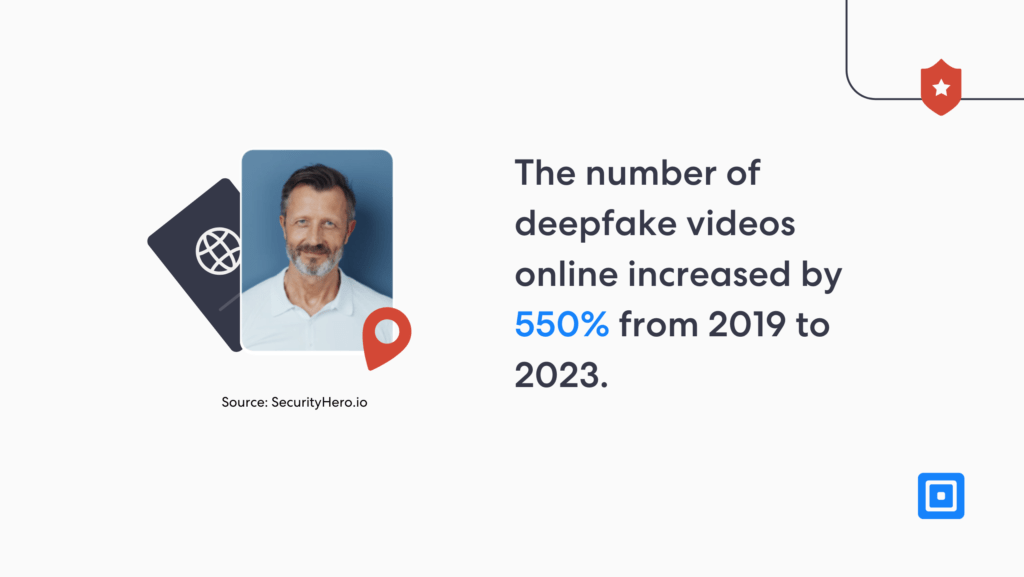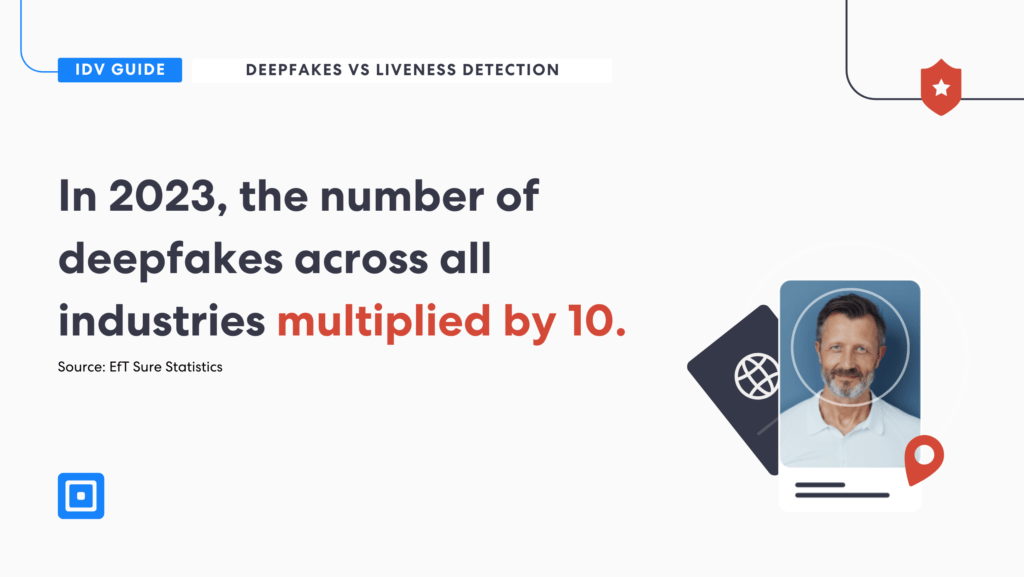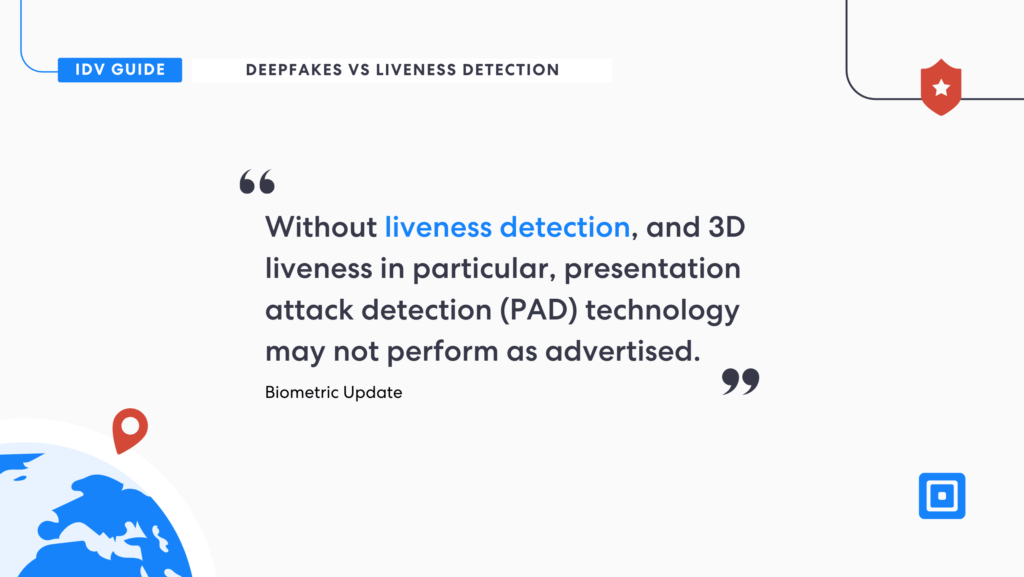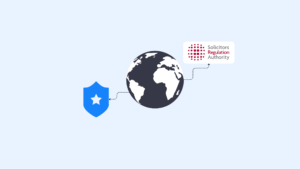In today’s digital landscape, it’s almost impossible to distinguish a deepfake video from an authentic one. The rise of new AI-powered attacks leaves organizations struggling to find the proper security infrastructure to fight back. The most powerful tool is certainly biometric liveness detection technology, allowing for secure biometric verification processes and enhanced security. Liveness detection provides a sophisticated facial authentication process that can examine subtle micro-expressions, skin texture, and more – stopping presentation attacks through the analysis of biometric data. This guide will explore how deepfake technologies are subverting facial authentication processes, the new threats they pose, and how organizations can protect themselves with liveness detection.

How Does Liveness Detection Work?
Liveness detection is an AI-powered tool that leverages advanced algorithms to differentiate presentation attacks from authentic users, such as spoofed images or deepfakes. It is the primary defense against evolving attacks.
These solutions work by processing large amounts of data in real time, often using 3D scanning. When running a facial scan, the system creates a 3D face map of facial features that can be compared against existing data. Liveness detection then analyzes movements, helping the facial recognition system confirm the existence of a live person.
How Deepfakes Subvert Facial Recognition Technology
While many might be aware of deepfakes existing amongst mainstream media, many organizations don’t realize just how realistic they are becoming. Recent data showed that “human subjects identified high-quality deepfake videos only 24.5% of the time.” Without the right tools, businesses cannot spot deepfakes 75% of the time, proving the urgent need for liveness detection.
Key Deepfake Statistics:
- Human subjects identified high-quality deepfake videos only 24.5% of the time.
- 1 in 4 leaders are not aware of deepfakes or the threat that they pose.
- 1 in 10 executives have already experienced security threats from deepfakes.
- In 2023, the number of deepfakes across all industries multiplied by 10.

The market is slowly adopting liveness detection as businesses confront the threat of deepfake technology. Bret Kinsella, CEO and founder of Voicebot.ai, argues that while deepfake detection is currently still considered a novelty, its time as such is limited. Earlier this year, Kinsella stated,” While deepfake detection is essentially a novelty for companies in their call centers today, it will become widely adopted and increasingly be viewed as standard security hygiene over the next five years.”
Just about anyone can now create deepfakes using accessible software such as DeepFaceLab, which is used to create over 95% of deepfakes. Videos that explain how to create deepfakes can now be found on YouTube, with in-depth tutorials that are globally accessible.
Biometric Liveness in the Digital Age
Identity verification should be a requirement for every online platform, but a standard document check can be coupled with biometric authentication for optimal security. A biometric system can perform a liveness check, using a facial scan to ensure a live human being is presenting the identity. Biometric traits are analyzed, with an active liveness check prompting users to conduct motion analysis. Biometric liveness detection work is critical for ensuring fraud prevention within onboarding processes.
Without liveness detection, and 3D liveness in particular, presentation attack detection (PAD) technologies may not perform as advertised.
Biometric Update, a leading industry news platform focused on biometric technology and digital identity, states, “Biometrics are replacing legacy knowledge-based authentication for remote and unsupervised authentication scenarios. But the latest liveness detection report from FaceTec argues that without liveness detection, and 3D liveness in particular, presentation attack detection (PAD) technologies may not perform as advertised.”
Standard facial recognition systems fail to detect spoof attacks, which include high-quality 3D silicone masks or deep fakes.
Liveness detection is critical, as systems are unable to detect signs of fraud without analyzing a biometric sample. Liveness detection algorithms enhance security and effectively prevent fraudsters, and checks with user interaction (active liveness detection) provide the highest level of security.
Active Liveness Detection Technology
Active liveness detection consists of prompting user actions in real time. Users are guided through the prompts and are often required to perform movements such as blinking, smiling, turning their heads, or nodding.

Real-time feedback allows the liveness detection technology system to examine facial features and behavioral subtleties, tracking subtle natural expressions. These might include muscle movement or slight head shifts. Again, micro-expressions are very difficult to replicate within a fraudulent attempt.
Passive Liveness Detection Technology
Passive biometric checks don’t require the user to perform real-time actions as they don’t analyze movement. AI-powered machine learning software runs checks swiftly, with minimal user interaction. With users and potential fraudsters unaware that an identity verification check is occurring, the check is more spoof-proof.
Unlike active liveness, passive liveness is much quicker and offers a smoother experience since users don’t need to perform several actions in front of the camera. Both liveness checks are highly effective in helping organizations detect and prevent fraud.
Biometric Liveness Detection with ComplyCube
ComplyCube offers a state-of-the-art biometric check that leverages liveness detection technology. The solution analyses facial biometric data samples and examines the validity of documentation in conjunction. Some of the features of their solutions include:
Robust facial recognition and similarity: ComplyCube’s advanced ISO 30107-3 and PAD Level 2-certified biometric liveness detection technology ensure that the individual presenting an identity document matches the submitted details. Their Identity Verification (IDV) technology offers a thorough analysis by combining biometric and behavioral factors, providing the highest level of verification assurance.
Advanced document verification: ComplyCube combines AI with skilled experts to perform thorough checks on ID documents, ensuring they haven’t been tampered with, forged, copied from the internet, expired, or blacklisted. Supported documents include passports, travel documents, driver’s licenses, national ID cards, residence permits, and visa stamps.
Expert liveness detection: Their AI-powered PAD-Level 2 liveness detection software can determine genuine customer presence and identify imposters. ComplyCube leverages anti-spoofing detection that protects businesses from sophisticated attacks.
Seamless biometric enrolment: A top-tier guided face capture technology that ensures seamless authentication for accessing Finance, Telecommunications, Travel, Enterprise Services, and more.

Contact their expert compliance team today and safeguard your business from identity fraud.



